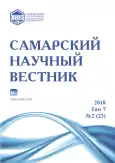Растительность памятника природы «Гурьев овраг» (Шигонский район Самарской области)
- Авторы: Новикова Л.А.1, Саксонов С.В.2, Васюков В.М.2, Горлов С.Е.2, Сенатор С.А.2, Соловьева В.В.3
-
Учреждения:
- Пензенский государственный университет
- Институт экологии Волжского бассейна РАН
- Самарский государственный социально-педагогический университет
- Выпуск: Том 7, № 2 (2018)
- Страницы: 90-94
- Раздел: 03.02.00 – общая биология
- URL: https://journals.rcsi.science/2309-4370/article/view/21734
- DOI: https://doi.org/10.17816/snv201872118
- ID: 21734
Цитировать
Полный текст
Аннотация
Памятник природы регионального значения «Гурьев овраг» расположен в 1 км северо-западнее с. Климовка в Шигонском районе Самарской области. Южную и юго-западную часть участка занимает овраг, устьем открывающийся в Куйбышевское водохранилище. Правый склон оврага более пологий и зарос широколиственным лесом, левый – крутой, сильно эрозированный, известный под названием гора Гусиха. В устье оврага и вдоль коренного берега сформировались оползневые террасы. Описана кальцефитная флора и растительность левого склона Гурьева оврага (гора Гусиха). Всего сделано 5 описаний, из которых одно (№ 14) располагалось в нижней части горы, а четыре других – в верхней (описания № 15–18). Описания сделаны на крутых склонах (угол наклона 40–50°) юго-восточной экспозиции. На описываемом участке преобладает петрофитная полукустарничковая растительность с доминированием Artemisia salsoloides (ПП от 1,0 до 30,0%), Ephedra distachya (ПП от 0 до 30,0%), Bassia prostrata (ПП от 0 до 15,0%), Thymus dubjanskyi (ПП от 0 до 15,0%), Onosma volgensis (от 0 до 15,0%), Anthemis trotzkiana (от 0 до 5,0%); реже встречается Linum uralense (от 0 до 1,0%). Распространение получили сообщества из формации с доминированием Artemisia salsoloides (описания № 14, 16), которые занимают нижние и средние части крутых склонов горы Гусихи и относятся к двум разным ассоциациям. В нижней части склонов развивается юзепчуковокачимово-простертопрутняково-солянковиднополынная ассоциация [Artemisia salsoloides + Bassia prostrata + Gypsophila juzepczukii], а в средней – волжскооносмово-солянковиднополынная ассоциация [Artemisia salsoloides + Onosma volgensis]. В верхней части крутых склонов развиваются ассоциации из формаций с доминированием других видов полукустарничков: Bassia prostrata, Ephedra distachya и Thymus dubjanskyi (описания № 15, 17, 18): волосатикоковыльно-солянковиднополынно-простертопрутняковая [Bassia prostrata + Artemisia salsoloides + Stipa capillata], простертопрутняково-солянковиднополынно-двуколосковоэфедровая [Ephedra distachya + Artemisia salsoloides + Bassia prostrata] и юзепчуковокачимово-корнух-троцкогопупавко-дубянскочабрецовая [Thymus dubjanskyi + Anthemis trotzkiana + Gypsophila juzepczukii] ассоциации. В условиях наименьшего эрозионного процесса постепенно в сообщества внедряются разные виды злаков (Stipa capillata), а при усилении эрозионных процессов – представители разнотравья (Gypsophila juzepczukii) или полукустарничков (Artemisia salsoloides, Anthemis trotzkiana), что способствует возобновлению этих особенно редких для Самарской области видов.
Полный текст
Открыть статью на сайте журналаОб авторах
Любовь Александровна Новикова
Пензенский государственный университет
Email: la_novikova@mail.ru
доктор биологических наук, доцент, профессор кафедры общей биологии и биохимии
Россия, ПензаСергей Владимирович Саксонов
Институт экологии Волжского бассейна РАН
Email: svsaxonoff@yandex.ru
доктор биологических наук, профессор, временно исполняющий обязанности директора, заведующий лабораторией проблем фиторазнообразия
Россия, ТольяттиВладимир Михайлович Васюков
Институт экологии Волжского бассейна РАН
Email: vvasjukov@yandex.ru
кандидат биологических наук, научный сотрудник лаборатории проблем фиторазнообразия
Россия, ТольяттиСергей Евгеньевич Горлов
Институт экологии Волжского бассейна РАН
Email: gorlov87@yandex.ru
аспирант лаборатории проблем фиторазнообразия
Россия, ТольяттиСтепан Александрович Сенатор
Институт экологии Волжского бассейна РАН
Email: stsenator@yandex.ru
кандидат биологических наук, старший научный сотрудник лаборатории проблем фиторазнообразия
Россия, ТольяттиВера Валентиновна Соловьева
Самарский государственный социально-педагогический университет
Автор, ответственный за переписку.
Email: soloveva@pgsga.ru
доктор биологических наук, профессор кафедры биологии, экологии и методики обучения
Россия, СамараСписок литературы
- Клаус К. Флоры местные приволжских стран. СПб., 1852. 312 с.
- Калашникова О.В., Плаксина Т.И. Кальцефильная флора меловых обнажений провинции Приволжской возвышенности Самарской области // Известия Самарского научного центра Российской академии наук. 2010. Т. 12, № 1 (13). С. 691-695.
- Каталог государственных памятников природы Куйбышевской области. Куйбышев: Ин-т Волгогипрозем, Куйб. обл. совет ВООП. 1989. 73 с.; 1990. 72 с.
- Плаксина Т.И., Головин В.И. Гурьев овраг // «Зеленая книга» Поволжья: Охраняемые природные территории Самарской области / сост. А.С. Захаров, М.С. Горелов. Самара: Кн. изд-во, 1995. С. 299-300.
- Памятники природы Куйбышевской области / сост. В.И. Матвеев, М.С. Горелов. Куйбышев: Кн. изд-во, 1986. 157 с.
- Реестр особо охраняемых природных территорий регионального значения Самарской области / сост. А.С. Паженков. Самара: Экотон, 2010. 259 с.
- Захаров А.С. Рельеф Куйбышевской области. Куйбышев, 1971. 86 с.
- Иванов А.М., Поляков К.В. Геологическое строение Куйбышевской области. Куйбышев: Изд-во Куйбыш. обл. музея краеведения, 1960. 81 с.
- Ипатов В.С. Методы описания фитоценоза. СПб.: СПбГУ, 2000. 56 с.
- Ипатов В.С., Мирин Д.М. Описания фитоценоза. Метод. рекомендации. СПб.: СПбГУ, 2008. 71 с.
- Новикова Л.А., Леонова Н.А. Меловая растительность Пензенской области на примере памятника природы «Субботинские склоны» // Известия высших учебных заведений. Поволжский регион. Естественные науки. 2014. Вып. 2 (6). С. 46-56.
- Новикова Л.А., Леонова Н.А., Панькина Д.В., Кулакова Д.А. Кальцефитная растительность Пензенской области как резерват редких и реликтовых растений (памятник природы «Субботинские склоны») // Известия Самарского научного центра РАН. 2014. Т. 16, № 1. С. 108-114.
- Новикова Л.А., Леонова Н.А. Современное состояние кальцефитной растительности Пензенской области // Известия Самарского научного центра РАН. 2014. Т. 16, № 5. С. 158-163.
- Новикова Л.А., Панькина Д.В., Миронова А.А., Кулагина Е.Ю. Редкие растения и растительные сообщества каменисто-песчаных степей Пензенской области (на примере памятников природы «Ардымский шихан» и «Ольшанские склоны») // Известия Самарского научного центра РАН. 2015. Т. 17, № 4 (4). С. 691-698.
- Новикова Л.А., Панькина Д.В., Миронова А.А., Кулагина Е.Ю. Петрофитный элемент во флоре Пензенской области (на примере двух урочищ «Большая ендова» и «Малая ендова» // Известия Самарского научного центра РАН. 2016. Т. 18, № 5. С. 112-117.
- Красная книга Российской Федерации (растения) / гл. редкол. Ю.П. Трутнев и др.; сост.: Р.В. Камелин и др. М.: Т-во научных изданий КМК, 2008. 855 с.
- Красная книга Самарской области. Т. 1. Редкие виды растений, лишайников и грибов / под ред. чл.-кор. Г.С. Розенберга и проф. С.В. Саксонова. Тольятти: ИЭВБ РАН, 2007. 372 с.
- Плаксина Т.И. Редкие и исчезающие растения Самарской области. Самара: Самарский университет, 1998. 272 с.
- Плаксина Т.И. Конспект флоры Волго-Уральского региона. Самара: Самарский университет, 2001. 388 с.
- Саксонов С.В., Сенатор С.А. Путеводитель по Самарской флоре (1851-2011). Флора Волжского бассейна. Т. 1. Тольятти: Кассандра, 2012. 511 с.
Дополнительные файлы






